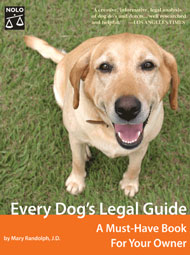Condominiums and Planned Developments
People looking to buy a condominium or planned subdivision unit (frequently called planned unit development or P.U.D.) should be prepared for rules. Lots of rules, covering everything from the kind of shutters you can have on the windows to how many pets you can have and what color you can paint the doghouse.
These rules can be found in the development's "Covenants, Conditions, and Restrictions" (CC&Rs), the bylaws or declarations of a condominium owners' association or other document. They often forbid or strictly limit the number of animals that residents can have, and residents can do little to get around them. If a resident violates a no pets rule, the condominium governing body can get a court order (injunction) that prohibits the resident from keeping the pet.26
A resident who wants to challenge a no pets rule successfully must prove one of three things:
- the rule is being enforced arbitrarily or unfairly
- it is unreasonable, or
- it was not adopted by the proper procedure.
Unfair enforcement. If a no pets rule isn't enforced evenly - if, for example, some owners are singled out for enforcement and others are left alone - the targeted owners may be able to challenge the enforcers. In most cases, this is the strongest tack to take. For example, a Florida man won the right to keep his dog after a condominium association tried to enforce a pet restriction retroactively. The association passed a rule that residents could not keep dogs unless the pets were replacements for dogs that had been registered with the association a year earlier. A court struck down the rule.27
Reasonableness. This avenue of attack is not promising when it comes to a condominium rule that forbids pets or allows only one small pet. Courts always say no pets restrictions in condominiums are reasonable, given residents' concerns about "potentially offensive odors, noise, possible health hazards, clean-up and maintenance problems, and the fact that pets can and do defile hallways, elevators, and other common areas."28 Rules that allow residents to keep the dogs they have, but not to replace them if they die, have also been upheld in some states.29 Subdivisions, where residents are more widely spaced, rarely ban dogs, and such a prohibition might be more vulnerable to a reasonableness challenge.
Improperly adopted rules. Every condominium has a decision-making group made up of some or all the unit owners. Whatever its form, it must follow its own rules when it adopts regulations that affect all the unit owners. That means following the requirements for voting, giving notice to owners and holding meetings. As a practical matter, it may not matter that a rule was improperly adopted; after all, the rule-makers can probably just go do it again, this time getting the procedure right. But if the improper procedure really did make a difference - so that a new owner didn't know about the rule, for example - it's possible that a resident might get to hang on to a pet as a result.
For example, the board of directors of a Massachusetts condominium complex adopted a rule that prohibited animals outside of the units, and sued a couple for walking their golden retriever in the common areas. An appeals court ruled that the inside-only rule was invalid and unenforceable because it had never been put to a vote of the unit owners and wasn't, as required by state law, in the bylaws or master deed of the condo organization.30
THE ALOHA STATE WELCOMES PETS
In Hawaii, if bylaws don't forbid pets, any condominium owner who has a pet may replace that pet if it dies.
People who rent from condominium owners are subject to the same restrictions the owners are. Bylaws may not forbid tenants from keeping pets if owners are allowed to keep them, and the owner of the unit agrees.31
